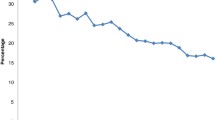Abstract
Work requirements and time limitations on benefits have forced welfare administrators to be more aggressive in moving welfare recipients into the workplace. This paper tracks a cohort of Georgia welfare leavers from 1992 to 2001, estimating the timing of recidivism using duration models. Of the case heads that leave the program within a two-year period, 15.3 percent remain out of welfare for less than three months and 35 percent returned within one year. There is also a relatively high risk of welfare recidivism for a much longer period than estimated in previous studies. Furthermore, successful employment may be affected not only by the presence of job growth but also by the industrial mix in which jobs are growing and by the residential location of welfare leavers.
Similar content being viewed by others
References
Blank, R. M.; Ruggles, P. “Short-Term Recidivism among Public-Assistance Recipients,” American Economic Review, 84, 2, 1994, pp. 49–53.
Bruce, D.; Barbour, K.; Thacker, A. “Welfare Program Reentry among Post-reform Leavers,” Southern Economic Journal, 70, 2004, pp. 816–36.
Cameron, C. A.; Trivedi, P. K. Microeconometrics: Methods and Applications (chapters 17–19), New York: Cambridge University Press, 2005.
Coulton, C.; Leete, L.; Bania, N. “Housing, Transportation, and Access to Suburban Jobs by Welfare Recipients in the Cleveland Area,” in: S. J. Newman ed., The Home Front: Implications for Welfare Reform for Housing Policy, Washington, District of Columbia: Urban Institute, 1999, pp. 123–48.
Ellwood, D. T. “Targeting ‘Would Be’ Long-Term Recipients of AFDC,” Washington, District of Columbia: Report from the US Department of Health and Human Services, 1986.
Hughes, M. A. “Employment Decentralization and Accessibility: A Strategy for Stimulating Regional Mobility,” Journal of the American Planning Association, 53, 6, 1991, pp. 288–98.
—. “A Mobility Strategy for Improving Opportunity,” Housing Policy Debate, 6, 1, 1995, pp. 271– 97.
Ihlanfeldt, K. R. “The Spatial Mismatch between Jobs and Residential Locations within Urban Areas,” Cityscape: A Journal of Policy Development and Research, 1, 1, 1994, pp. 219–44.
Isard, W.; Azis, I. J.; Drennan, M. P.; Miller, R. E.; Saltzman, S.; Thorbecke, E. Methods of Interregional and Regional Analysis. Brookfield, Vermont: Ashgate, 1998.
Kalbfleisch, J. D.; Prentice, R. L. The Statistical Analysis of Failure Time Data, 4th ed., New York: Wiley, 2002, pp. 13–9.
Lane, J.; Shi, J.; Stevens, D. “New Uses of Administrative Records in Welfare-to-Work Policy and Program Management Decisions: Employer Hiring and Retention of Former Welfare Recipients,” Northwestern University/University of Chicago Joint Center for Poverty Research Working Paper, Chicago, 1998.
Long, S. K. “Welfare Participation and Welfare Recidivism: The Role of Family Events,” The Urban Institute Working Paper Series, Washington, District of Columbia, 1990.
Ong, P. “Work and Automobile Ownership among Welfare Recipients,” Social Work, 20, 4, 1996, pp. 255–62.
Osterman, P. “Welfare Participation in a Full Employment Economy: The Impact of neighborhood,” Social Problems, 38, 4, 1991, pp. 475–491.
Raphael, S. “The Spatial Mismatch Hypothesis and Black Youth Joblessness: Evidence from the San Francisco Bay Area,” Journal of Urban Economics, 43, 1, 1998, pp. 79–111.
Author information
Authors and Affiliations
Corresponding author
Rights and permissions
About this article
Cite this article
Gurmu, S., Smith, W.J. Recidivism among Welfare Recipients: The Role of Neighborhood and Access to Employment. Atl Econ J 34, 405–419 (2006). https://doi.org/10.1007/s11293-006-9027-9
Received:
Accepted:
Published:
Issue Date:
DOI: https://doi.org/10.1007/s11293-006-9027-9




